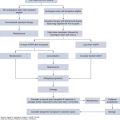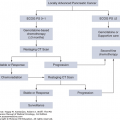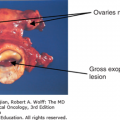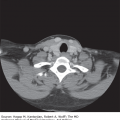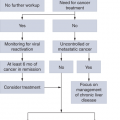OVERVIEW
Carcinomas of unknown primary (CUPs), with their heterogeneous presentations, pose a challenge on the diagnostic and therapeutic fronts. Depending on the extent of evaluation, CUP comprises 3% to 5% of all tumors diagnosed (1,2,3). A working definition for CUP is biopsy-proven metastatic cancer with no identifiable primary source by history; physical examination; chest radiography; complete blood cell count; chemistry; computed tomography (CT) of the chest, abdomen and pelvis; prostate-specific antigen (PSA) in men; and mammography in women (2). The natural history of disease for CUP is diverse and is dependent on multiple variables, such as, age, number of metastatic sites, dominant area of disease, and histology. This considerable heterogeneity presents a challenge to the systematic study of CUPs. In addition, the emergence of sophisticated imaging, robust immunohistochemistry (IHC), and genomic and proteomic tools have challenged the “unknown” designation. Depending on histologic features, sites of disease, and performance status, a small but significant minority of patients will be long-term survivors, and it is important to identify these groups of patients (4,5).
This chapter discusses the evaluation of patients with CUP and optimal therapeutic strategies in the era of sophisticated diagnostics. The differing natural histories in CUP, depending on both the sites of disease and histology, are also discussed. Studies showed that, in this population, a search for the primary tumor beyond “routine” evaluation is unrewarding in the majority of patients (5). This fact has caused much consternation for both patients and physicians. The foundation for cancer treatment traditionally relies on identification of the tumor origin, thereby allowing treatment to be chosen based on the known natural history as well as specific therapies that have been proven effective for the cancer; this is becoming even more important with the rapid emergence of targeted therapies. Without knowledge of the primary site, the oncologist is often hesitant to recommend therapy, especially given the disease heterogeneity. Although most patients with metastatic CUP have tumors that respond poorly to current treatments and will consequently have a poor prognosis, it has become evident over the last two decades that subsets of patients with CUP have a favorable prognosis and respond to chemotherapy or can be successfully treated with regional therapy alone. The current era of sophisticated diagnostics and introduction of targeted therapies has been particularly important in the CUP setting; this cancer entity is the epitome of personalized therapy.
EPIDEMIOLOGY
The incidence of CUP cancers as estimated from the cancer registries and databases of “unknown and unspecified cancers” is reported to be approximately 3%-4% of all cancers (6). This is probably an overestimation because this group includes a mix of patients: those with true CUP, those with primaries not yet diagnosed at the time of death, and those with difficult-to-diagnose tumors. Further, improved imaging allowing identification of small primary tumors suggests that the incidence of true CUP is decreasing.
A minority of patients (10%) with CUP have a history of an antecedent cancer. In autopsies performed before the advent of CT, the occult primary tumor was identified in 60% to 80% of cases. In one autopsy series, the two most commonly identified primary sites were the pancreas (20%) and lungs (18%) (7,8). Given the current high-quality CT imaging and positron emission tomographic (PET) scans, it is unclear whether these cancer profiles are still the majority.
The classification of CUP continues to evolve. The last four decades have seen a shift in our understanding of CUP. First, improved imaging increased our confidence for the entity termed occult primary. Later, “favorable” CUP subsets were determined, based primarily on histopathology, the pattern of spread of select CUP cancers, and serum markers. Subsequently, with the advent of novel IHC markers and advances in diagnostic pathology, tissue of origin (ToO) profiles were described that assigned additional putative primary sites to CUP cancers based on IHC patterns. Current research involves the application of proteomic and genomic tools to CUP cancers.
BIOLOGY, CHROMOSOMAL ABERRATIONS, AND MUTATIONAL PROFILING
Carcinomas of unknown primary, despite their heterogeneity, are a clinically unique oncologic entity; as such, they share many common features that set them apart from other malignancies. The central unifying clinical feature of CUP is the absence of a detectable primary tumor. Previous studies have shown that, even after an autopsy, the primary site will not be identified in 20% to 40% of cases; that number is likely much lower with significant improvements in imaging. At present, it is not known why primary carcinomas exhibit this unique biological behavior. One current hypothesis is that the acquisition of a “metastatic phenotype” is an early event in CUPs, soon after oncogenesis, thus enabling cells to metastasize early, before the development of a clinically detectable tumor (9). It has also been hypothesized that the primary tumors may regress or involute before the metastases become clinically evident, attributed to a host immunologic response. A third hypothesis is that the primary tumor is exposed to antiangiogenic factors locally, whereas the metastases acquire the angiogenic phenotype after a period of dormancy (10).
Several studies have demonstrated a specific nonrandom pattern of chromosomal aberrations that seems to be unique to CUPs. These data suggest that some of these genetic changes may be the underlying cause of the metastatic phenotype. Carcinoma of unknown primary is characterized by greater genetic instability, with massive GAs, when compared with other distant metastases. In a study by Pantou and colleagues (11), cytogenetic profiling of tumors from 20 patients with CUP was performed, revealing an average of 11 chromosomal changes per case. Of the three histologic subtypes in this study, adenocarcinomas had not only the highest number of cytogenetic changes (16 vs 3) but also involvement of distinct sites (4q31, 6q15, 10q25, and 13q22) when compared with carcinomas or undifferentiated malignancies. The latter group was distinguished by the involvement of changes at 11q22. Overall, the most commonly rearranged chromosomal regions were 1q21, 3p13, 6q21-23, 7q22, 11p15-12, and 11q14-24. The number of cytogenetic alterations was found to be prognostically relevant. Median survival was significantly greater for patients with five or fewer cytogenetic changes compared with those with more than five changes (3 vs 18 months, P = .003). An older study of 12 CUP cell lines also demonstrated a preponderance of chromosome 1 abnormalities. These changes were observed on both the long arm (eg, 1p deletion, isochromosome 1p, and translocations with a 1p breakpoint) and on the short arm (1q21), suggesting the importance of chromosome 1 in the biology of CUPs (12). Chromosome 1p aberrations are also commonly associated with advanced malignancies.
Chromosome 12 abnormalities have also been shown in CUP. This is of particular interest because one of the observed alterations, isochromosome 12p (i12p), is present in as many as 80% of germ cell tumors. Motzer and colleagues reported that 30% of patient tumors in their series had either i12p or 12q deletions. The presence of either of these two cytogenetic abnormalities was found to be predictive of a complete response to cisplatin-based chemotherapy (75% vs 17%, P = .002) (13,14). In the current era of sophisticated IHC, we rarely miss a patient with an extragonadal presentation and seldom order cytogenetics to inform therapeutic plans.
The tumor suppressor gene p53 is commonly mutated in human cancers, especially in advanced malignancies. Paradoxically, this does not seem to be true in CUP. Bar-Eli and colleagues found p53 mutations to be less frequent than expected (26%) in CUP after evaluating 15 biopsy specimens and 8 cell lines (15). However, work by other researchers evaluating IHC studies of p53 in CUP has found this protein to be highly expressed in 70% of the tumors examined (16,17). Nevertheless, p53 expression has not been found to have prognostic relevance. Molecular studies have also demonstrated the overexpression of other oncogenes, such as c-myc, ras, bcl-2, and Her2/neu, in CUPs, but none have been found to have any correlation with either survival or response to chemotherapy (18).
More recent data with next-generation sequencing likely has therapeutic implications for patients with CUP, and it is exciting times for CUP researchers to extend the therapeutic envelope. In a recent study, Ross and colleagues presented results from a retrospective study of 200 consecutive CUP tumor specimens that that underwent comprehensive genomic profiling (CGP) using the hybrid-capture–based Foundation-One 10 assay (19). The DNA extracted from these CUP tumor specimens was analyzed after hybridization capture of 3,769 exons from 236 cancer-related genes and 47 introns of 19 genes commonly rearranged in cancer. There were 125 adenocarcinomas of unknown primary site (ACUPs) and 75 nonadenocarcinomas (non-ACUPs). The authors reported that a large number of CUP samples (85%) harbored at least one clinically relevant genomic alteration (GA) with the potential to influence and personalize therapy. The mean number of GAs was 4.2 GAs per tumor. The ACUP tumors were more frequently driven by GAs in the receptor tyrosine kinase (RTK)/Ras/mitogen-activated protein kinase (MAPK) signaling pathway than non-ACUP tumors. The authors concluded that CGP can identify novel treatment paradigms and suggested that early testing may have utility in CUP management. These data do illustrate some important considerations in the management of CUP cancers, as discussed in this chapter.
NATURAL HISTORY AND CLINICAL PRESENTATION
The clinical course of patients with CUP varies widely. Median survival in large retrospective studies has ranged from 11 weeks to 11 months. In the University of Texas MD Anderson Cancer Center study, the 5-year overall survival (OS) rate was only 11%. Although survival is poor as a whole, there are certain prognostic variables that correlate with longer survival, including disease limited to one organ site, involvement of lymph nodes only, and histologic diagnoses of squamous or neuroendocrine carcinoma. Variables suggestive of a poor prognosis include male sex, histologic diagnosis of adenocarcinoma, and metastatic involvement of the liver, lungs, bone, pleura, or brain (Table 45-1) (4).
| Favorable Prognosis | Poor Prognosis |
|---|---|
| Extragonadal germ cell syndrome | Liver metastases (nonneuroendocrine) |
| Isolated single small metastasis | Pleural or lung metastases |
| Papillary peritoneal adenocarcinoma (women) | Adrenal metastases |
| Isolated axillary adenocarcinoma (women) | Multiple brain metastases |
| Cervical adenopathy (squamous cell) | |
| Isolated inguinal adenopathy | |
| Neuroendocrine histology |
By performing multivariate analyses on a consecutive series of 1,000 patients with CUP with classification and regression tree (CART) analysis, Hess and colleagues (4) were able to more closely study the interactions between different clinical variables and how this influenced survival.
Patients with CUP present with symptoms and signs similar to those of patients with advanced malignancies of known origin. In one review, the most common symptoms at presentation of CUP were general deterioration (73%), digestive symptoms (58%), liver enlargement (58%), abdominal pain (56%), respiratory symptoms (45%), ascites (26%), and node enlargement (16%) (20). Most patients with CUP present with multiple metastases, with three or more organs involved. In patients with a dominant (or single) site of metastasis, the most common reported sites were liver (25%), bone (22%), lungs (20%), lymph nodes (15%), pleural space (10%), and brain (5%).
DIAGNOSTIC EVALUATION
In the past, minimalist diagnostic strategies had been advocated, limiting the scope of initial evaluations to differentiate only between treatable and untreatable disease. Others have supported a more aggressive approach, wherein a complete assessment of the extent of the disease and detection of the primary tumor site are attempted. In our experience, a more pragmatic approach is better. Extensive evaluation of all patients presenting with metastases is an expensive and wasteful extreme that does not benefit patients. In one study, the average cost of evaluating a patient with CUP was $17,973 and much higher with recent testing (21,22). In that study, mean survival was 8.1 months, representative of the natural history of CUP, with only 18% of patients surviving 1 year. However, a strictly minimalist approach may result in the oversight of treatable and potentially curable neoplasms.
An important determinant of the appropriate extent of evaluation for any patient with CUP is whether the data obtained by a diagnostic test will influence treatment decisions. If a treatable or potentially curable cancer is strongly suspected (eg, a germ cell tumor or lymphoma or oligometastatic disease treated with surgery or multimodality therapy), further investigation should proceed until a precise clinical diagnosis can be made, provided that therapy is not unreasonably delayed. The recommended general approach at the present time is thus one of a directed evaluation based on clinical presentation and pathologic findings; predictions of tumor origin or mutations from molecular profiling techniques may also play a role in streamlining the scope of evaluation.
A thorough medical history should be obtained, and a physical examination, including a digital prostate examination in men and a breast and pelvic examination in women, should be performed. Determination of the patient’s performance status, nutrition, and the presence or absence of concomitant medical illnesses and malignancy-related complications (eg, paraneoplastic syndromes or painful metastases) that may affect patient care is required.
Laboratory tests should include routine biochemical and hematologic surveys. The role of tumor markers in the evaluation of patients with CUP is often not diagnostic. Most tumor markers are nonspecific and are not useful for identifying a primary site or for prognostic purposes. Adenocarcinoma markers (eg, carcinoembryonic antigen [CEA], cancer antigen 125 [CA 125], CA 15-3, and CA 19-9) are often elevated in patients with CUP and cannot be reliably used to identify a specific primary site or to predict either OS or the exact burden of metastatic disease (23,24,25). Serum tumor markers may play a role in helping to evaluate patients for responses to therapy, although levels are not always predictive of response to chemotherapy.
Their selective use in a directed approach is more helpful than ordering a large battery of tumor markers on all patients who present with CUP. Men who present with metastatic adenocarcinoma and osteoblastic bone metastases CUP should have PSA and prostatic acid phosphatase levels measured. In all men with undifferentiated (or poorly differentiated) midline carcinomas, beta-human chorionic gonadotropin and alpha-fetoprotein levels should be measured, especially if the clinical presentation suggests an extragonadal germ cell tumor. In patients with hepatic tumors, alpha-fetoprotein levels should also be measured if there are risk factors or pathologic characteristics that suggest a possibility of primary hepatocellular carcinoma.
In the absence of contraindications, a baseline intravenous contrast CT scan of the chest, abdomen, and pelvis is the standard of care, as supported by the National Comprehensive Cancer Network and National Institute for Health and Clinical Excellence CUP radiology guidelines (26,27). Patients with CUP should then be approached in a “directed” fashion. Endoscopy of the upper and lower gastrointestinal (GI) tract is indicated for patients with abdominal complaints, ascites, liver metastases, or other findings in the initial workup and pathology that are indicative of a possible GI primary tumor.
All women with CUP and adenocarcinoma should undergo mammography. In cases of suspicious findings on a breast examination and negative mammography findings, patients should have breast sonography and a biopsy as indicated. Because both the sensitivity (23%-29%) and specificity (71%-73%) of mammography in detecting an occult carcinoma are low, breast magnetic resonance imaging (MRI) has been evaluated as an alternative in patients with a high suspicion for breast primary cancer. In the setting of isolated axillary adenopathy, MRI is sensitive in detecting occult primary breast cancers (>75%) and should be performed in women with isolated axillary adenopathy and negative mammography findings (28,29,30,31,32,33). Women with adenocarcinoma presenting with metastatic sites other than cervical or axillary adenopathy that are compatible with breast cancer (ie, bone, liver, or lungs) may also undergo breast MRI if the mammography findings are negative (32,33).
Patients with upper or midcervical adenopathy with a squamous cell carcinoma on pathology should undergo a thorough head and neck evaluation, including panendoscopy (ie, laryngoscopy, bronchoscopy, and esophagoscopy) with random biopsies. Ipsilateral or (more often) bilateral tonsillectomy has also been recommended as part of the staging process because this has been shown to identify an occult primary lesion deep in the tonsillar crypts in up to 30% of patients with this presentation of CUP (34,35,36). Computed tomography of the head and neck region is routinely done as part of the initial workup. In addition, the utility of 18-fluorodeoxyglucose positron emission tomography (FDG-PET) has been well documented in patients with squamous carcinoma and cervical adenopathy; small prospective and retrospective studies suggest that a primary head and neck tumor is identified in 25% to 30% of these patients (36,37,38,39,40,41,42). A recent retrospective review found that the primary tumor site was identified in 44% of these patients undergoing PET-CT fusion scans, and this modality appears to be emerging as a superior alternative to either PET or CT alone (38,39).
Outside the indication given previously, the role of PET-CT is unclear. Several small studies have evaluated the utility of PET in CUP patients (43,44). Moller et al reviewed (18) FDG-PET as a diagnostic tool for patients with extracervical CUP (44). They identified four publications (152 patients); these studies were retrospective and heterogeneous in their inclusion criteria, study design, and diagnostic workup prior to FDG PET-CT. The primary tumor was detected by FDG PET-CT in 39% of patients with extracervical CUP. Lung was the most commonly detected primary tumor site (≈50%). Pooled estimates of sensitivity, specificity, and accuracy of FDG PET-CT in the detection of the primary tumor site were 87%, 88%, and 87.5%, respectively. They concluded that FDG PET-CT may have a role in identification of the primary tumor in extracervical CUP; however, prospective studies with more uniform inclusion criteria are warranted. Although not studied prospectively, PET-CT scans may be useful in selected patients with solitary metastases prior to definitive locoregional therapies and in follow-up of patients with predominant bone disease (2).
All pathologic material obtained at biopsy from a patient with CUP should be evaluated by an experienced pathologist who is familiar with CUP workup. The pathologist should also be informed of the patient’s pertinent history and clinical findings so that he or she can recommend further analysis on the basis of this information. In the CUP world, pathology trumps radiology. Collaboration between the pathologist and treating oncologist is critical. Adequate tissue sampling is essential.
The CUP cancers include adenocarcinoma, poorly differentiated adenocarcinoma (60%); poorly differentiated carcinoma (PDC), undifferentiated carcinoma, or undifferentiated neoplasm (30%); squamous cell carcinoma (5%); and neuroendocrine cancer (2%). Rarely (2%), CUP can present as mixed tumors, including sarcomatoid, basaloid, and adenosquamous carcinomas (Table 45-2).
Adequacy of tissue is essential, especially when the pathologist has to make a diagnosis on deep fine-needle aspirations and there is insufficient tissue for IHC staining. The diagnosis of a poorly differentiated neoplasm implies that the pathologist is unable to classify it into any of the general neoplastic categories (carcinoma, lymphoma, melanoma, or sarcoma). Subsequent evaluation of this group of poorly differentiated lesions by means of special IHC techniques is warranted because some of these patients will have tumors that are potentially curable and very responsive to treatment. Many IHC reagents are at the disposal of the pathologist, making the histologic classification of the tumor easier (Table 45-3).
| Stain | Likely Primary Site |
|---|---|
| Estrogen/progesterone receptor, gross cystic disease fluid protein-15 (GCDFP-15), low molecular weight cytokeratin (CK) | Breast cancer |
| Thyroid transcription factor (TTF-1), CK7, CK20, surfactant protein A precursor (SP-A1) | Lung cancer |
| Prostate-specific antigen (PSA), epithelial membrane antigen (EMA), alpha-methylacyl coenzyme A racemase/P504S (AMACR/P504S) | Prostate cancer |
| Leukocyte common antigen (LCA), CD3, CD4, CD5, CD20, CD45 | Lymphoma |
| Vimentin, desmin,a factor VIIIb | Sarcoma |
| Chromogranin/synaptophysin, neuron-specific enolase, cytokeratin | Neuroendocrine tumor |
| EMA, β-hCG, AFP, placental alkaline phosphatase (PLAP) | Germ cell tumor |
| CK7, CK20,c uroplakin III | Urothelial malignancies |
| S100, vimentin, HMB-45, neuron-specific enolase | Melanoma |
| CK7, CK20,c CDX-2, carcinoembryonic antigen (CEA) | Colorectal cancer |
Especially useful are the antibodies to common leukocyte antigens present in lymphoma and the antibodies to PSA present in most prostate cancers. Other useful IHC markers include cytokeratin CK7, CK20, and thyroid transcription factor (TTF-1). Thyroid transcription factor is a nuclear transcription factor that is normally expressed in lung and thyroid tissues and in their neoplasms. Staining for TTF-1 is frequently positive in lung cancer, especially in adenocarcinomas (60%-75%) and small cell lung cancers (66%-87%); however, it is inconsistently expressed in squamous cell carcinoma. Among the various monoclonal antibodies against various cytokeratins, CK7 and CK20 can help differentiate between different solid tumors. (For instance, CK7 is more commonly associated with pulmonary or gynecologic malignancies, whereas CK20 is frequently seen in GI adenocarcinomas.) The CK7+/CK20− immunophenotype, in conjunction with TTF-1 staining, is suggestive of a lung primary and is a highly sensitive and specific method for differentiating primary pulmonary adenocarcinomas from metastatic extrapulmonary adenocarcinomas (Fig. 45-1) (45,46,47,48,49). In contrast, the CK7−/CK20+ immunophenotype is suggestive of a colorectal primary site. CK7+ and CK20+ dual staining suggest a malignancy of urothelial origin. Using light microscopy and IHC, a putative primary tumor may be assigned in up to a third of CUP cases. Immunohistochemistry can also suggest biomarker studies with potential therapeutic impact (eg, Kras, epidermal growth factor receptor [EGFR], Her2, and ALK mutations).
FIGURE 45-1
Immunohistochemical stains performed on the biopsy specimen from a patient with primary metastatic adenocarcinoma to a supraclavicular lymph node. Immunoperoxidase stains were positive for CK-7 (A) and TTF-1 (B) but negative for CK-20, (C), thus suggestive of metastatic non–small cell lung cancer.
Stay updated, free articles. Join our Telegram channel

Full access? Get Clinical Tree




